Originally introduced for sale in 1993, the HK USP (Universelle Selbstladepistole or Universal Self-Loading Pistol) is an overbuilt tank of a pistol that first came to market chambered in .40 S&W. While many other pistols at the time were suffering from cracked frames and other issues due to taking 9mm designs and tweaking them to fit the bigger and higher pressure .40 S&W, the USP was designed from the ground up with this cartridge in mind. Some 9mm and .45 ACP variants would be released later.
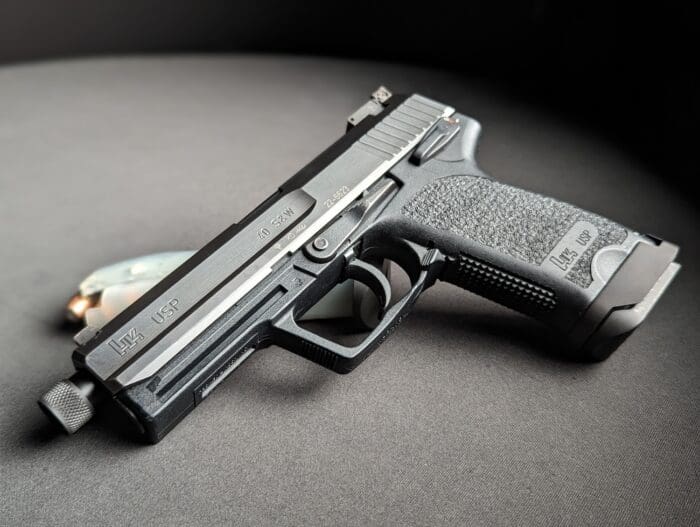
Revisions through the years were limited to changes in both 1996 and 2006 respectively, in which changes were made to the firing pin assembly, as well as the hammer and control latch mechanism, which was altered from a single piece unit to a two-piece unit. These updates are required for compatibility with the factory match trigger if a user wishes to install one in an early model USP model.
Original models like this one included traditional rifling, which was later transitioned to a polygonal rifling that anyone who owned a glock in the past 20 years or so is familiar with (up until the release of the Glock Gen 5 with the newly marketed match barrels, which have reverted back to traditional rifling).
These early models also did not have the captured recoil guide assemblies that models after 1994 would ship with. Slide weight was also reduced slightly by 1.1 ounces with these models.

If you already own a USP and would like to know what year yours was made, you can reference the two-letter date code on your slide and convert them via HK’s date coder
A – 0 B – 1 C – 2 D – 3 E – 4 F – 5 G – 6 H – 7 I – 8 K – 9 (ex KD = 1993)
Other Models
Shooters who appreciate these design principles aren’t limited to just the original USP. HK expanded the lineup with several other variants of the USP, namely: the USP Compact geared toward concealed carry (although arguably outmatched by today’s decreased size and increased capacity wonder nines).
The Expert, Match and Elite all contained longer barrels, slides and factory match triggers. These were aimed at shooting sports, competition and target shooting.
The USP Tactical, SD and compact-tactical provided users with factory threaded barrels alongside a slightly stouter modified captured recoil assembly to aid with suppressor usage.
Design and Features
The design of the USP is rugged and simple, and I personally believe it’s one of the best-looking polymer pistols ever produced. While it lacks modern ergonomic curves and interchangeable back straps, it’s still a comfortable shooter. While I’m a fan of things like TALON Grips and custom stippling, as far as factory texturing goes, the USP is just right.
Many shooters will prefer the grip angle, which is more reminiscent of a 1911 rather than Glocks, which some people take issue with at first.
The controls are another high point of the USP (that is IF you like them). The most controversial aspect is likely the magazine release, which on this firearm is an ambi-paddle release. For someone with smaller hands, I find that I don’t have to break my grip like I do with my Glocks, but it is something you need to train with to get used to.
The slide stop/release, like the trigger guard, was designed with gloves in mind. It’s massive and very easy to manipulate. This is also the single piece that needs to be popped out to field strip the gun.

Depending which variant you get (there are a whopping 10 of them) will dictate what your control lever looks like and how it functions. The version I have has been modified with an ambidextrous lever and is a DA/SA. HK offers(ed) the USP with controls on either side, with and without decocking functionality. If a person chooses an LEM trigger, which provides an experience more similar to a striker-fired handgun, the control lever is removed entirely.
The trigger guard is large enough for any gloves I’ve ever seen. The grip length itself is on the shorter size, at least compared to other full-sized pistols, but the addition of the jet funnel magazine well helps a bit here (as does the rubber magazine baseplates which come with the compact model). Speaking of magazines, factory capacities are:
- 15 rounds 9mm > upped to 18 rounds with the Jet Funnel kit
- 13 rounds .40 S&W > upped to 16 rounds Jet Funnel
- 12 rounds .45 ACP > no factory Jet Funnel kit available.
Sights
Factory sights on the standard model are steel three dots, which considering the price of the pistol is nice since you don’t have to run out and replace them for $100 right off the bat. Adjustable sights are offered for full size USP’s dovetail if you desire.

Expert models come factory with adjustable target sights, while the tactical models ship with blacked out suppressor height sights. If you do decide to change the sights on the expert, beware, the dovetail is different and sits lower in the slide, and aftermarket sights are not typically interchangeable and are model specific.
Shooting Impressions
The double action pull is, in my opinion, quite bad. It’s heavy, with the double action being around 11 pounds with a pretty long amount of travel. But who wants to shoot these on DA anyway? The SA trigger, while being nothing to write home about, is far from terrible. It is slightly better than adequate but is still enjoyable for the range and confidence inspiring for self-defense use. Luckily, there are upgrades and configurations galore to fine tune it (or convert it to LEM) should you desire.
The USP is more accurate than I am.
Reliability
If there is one thing the HK USP has a reputation for, it’s reliability. The USP features a dual spring recoil reduction system (and a modified buffer for the compact), which results in a marginal reduction in felt recoil. This system really shines in keeping the gun running. USPs have been tested with 20,000+ rounds (with the larger brother, the MK23, seeing over 30,000 rounds) without failures. What HK refers to as the “hostile environment” finish protects the slide, along with other anti-corrosion coatings protecting internal springs against wear and tear, mud and even salt water.
Customization & Aftermarket
The aftermarket for these guns is not as robust as something like a Glock, but there’s still plenty to modify if you feel the need. Factory options like the match trigger, Jet Funnel magwell and magazines are popular options.
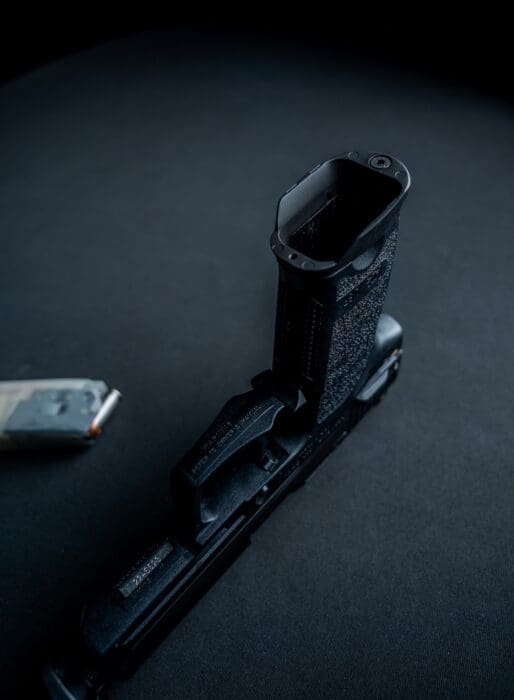
The Short Reset kit from Grayguns is also exceptionally popular. As with any gun, sights are interchangeable.
This is where the USP begins to show its age. Today, many shooters have migrated more and more toward pistol-mounted red dots, and the USP (while still being in production) does not offer a factory slide cut option. Companies like Langdon Tactical, fortunately, do offer packages.
HK was also one of the first to market with an integrated mount for a weapon light. Insight developed the UTL (Universal Tactical Light) to mount to the proprietary HK system. Now, 1913 rails have long since won that war, resulting in the need to use an adapter such as the GG&G, or the long discontinued Surefire MR09 mount to utilize a modern light.
Aftermarket barrels are also available, such as the RCM threaded barrel pictured (as is the Tactical recoil assembly from HK’s web shop) for suppressor use or those looking to shoot cast lead reloads. This USP is currently rocking a Silencerco Octane 45k. You can pick one up at Silencer Shop and wait times to get all your approvals taken care of have gone down drastically.
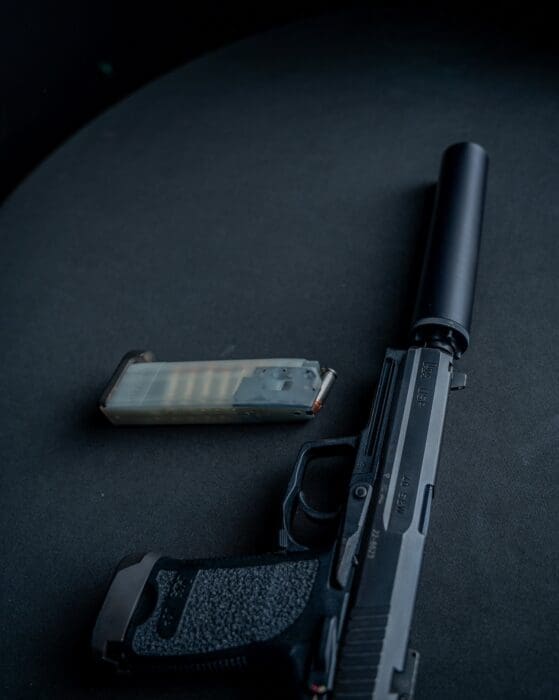
Holsters, especially with the addition of an adapter and a light, are few and far between. Your best bet to get what you need is from a custom or smaller batch manufacturer such as Next Level Tactical. Finding an off the shelf solution in 2024 is going to be a bear.
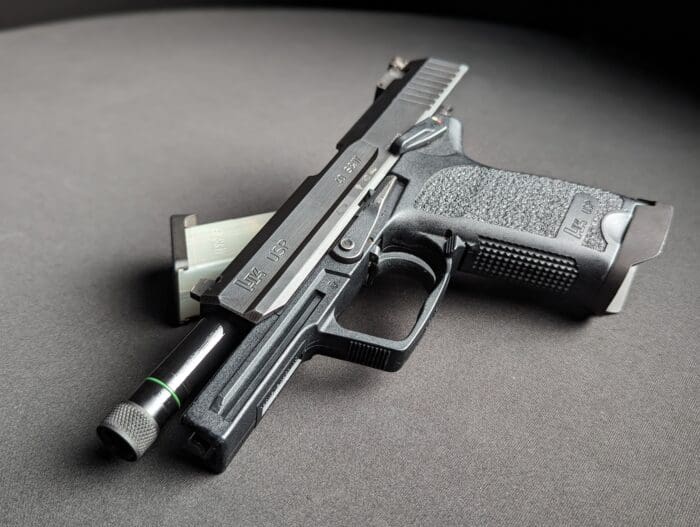
Value and Pricing
Paying MSRP on a USP in 2024 may be a tough pill to swallow for some, depending which version you’re getting. The .40 S&W is no longer in vogue, and there are droves of older police trade-ins, which can be found used for solid deals (if the chambering isn’t a dealbreaker for you). The 9mm and .45 variants typically fetch a premium in any version of their 40 brethren. Starting price for new USPs typically starts at the $900 price point and increases depending on caliber and version, with the Expert’s costing and additional $300-$400.
There are certainly more modern guns, with more features, less weight and greater capacity, that are on paper “better” guns…but they’re NOT a USP. If you’re a buyer of one of these “outdated” guns, you probably know what you’re getting into, and don’t care anyway!
Final Thoughts
Is the HK USP for you? While this gun is exceptionally reliable and offers various configurations tweaked for the end user, it’s outpaced by many features that some shooters consider “necessary” in today’s age. If it’s your only gun, nobody would knock you for the purchase, but your dollars are probably best spent on something newer with moderately improved ergonomics and increased capacity.
However, if you already have a few handguns in your collection that “cover your bases” and you’re considering expanding that collection to include another solid-shooting performer from a classic line of handguns, this is your sign to go ahead and pick one up ASAP!
Need Ammo? Check out Ammo To Go, the ammunition retail sponsor of TTAG gun reviews and simply a cool online place to fulfill all your ammo needs.

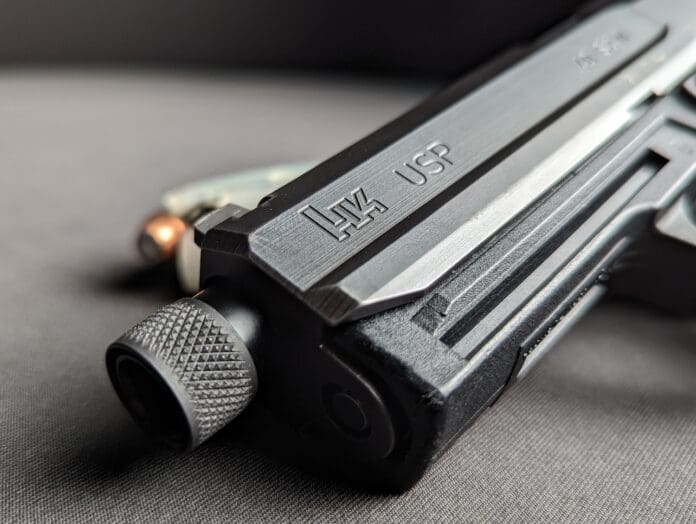



I like HK firearms. A lot. Owned a 91 since the early eighties. Had a 93. Wish I still did. Sometimes more than one. P7-M8? Several. SL-6? yeah. You get the point. I like HK. Except this one. Don’t misunderstand. the USP is a good pistol. It’s just another polymer framed DA/SA (with a variation that allows for SA carry). Neither fish, nor fowl. Make up my mind for me.
Have several in .45. They’re fantastic out of the box. It’s been my EDC for a long time for that reason. I wouldn’t bother tweaking it unless you’re trying for something specialist. As they come, they’re absofuckinglutely bomb proof which is what you want in a carry/defense pistol.
They work extremely well suppressed, though I don’t recommend a round muffler. But then, I don’t recommend round pistol suppressors for any pistol, lol.
Holsters do require some searching but they can be found from numerous manufacturers depending on what you want. If you want to carry it with a light AND suppressed like you’re Sam Fisher you’ll end up going custom. In that particular case you may consider a round suppressor to avoid snags on the holster because, well, you’re Sam Fisher.
The biggest drawback IMHO is that the rail on the frame is proprietary and requires you to add a pic-rail adaptor in a lot of cases. GG&G makes an excellent option in this regard.
I want to run mine with my x300u, which GG&G explicitly says not to. I believe something with the attachment method results in damaged rail sections. I’m waiting for a limited run of MR09 repros that should be available soon.
X300UA or UB? The A is notorious for having problems with USP rail adaptors, that’s on the light’s end of things in terms of how it mounts to the rail.
The UB shouldn’t give you any trouble. The adaptor should come with at least two different keys.
Honestly, I’d just swap lights unless you’re absolutely dead-set on running it in a holster that uses the X300 to lock the weapon into the holster.
The MR09 is nice but has issues with certain lights. It’s not uncommon that the UB is a very tight fit on that rail adaptor, like very hard to install. Lock it in a vice and install the light sort of hard. And, on top of that, because of the way the USP’s trigger guard is built the vertical is pretty far forward for where the MR09 puts the light. As such you can run into issues where the guard interferes with the switches on the light.
I’d see if you can find one to play with before I bothered to wait/pay for an MR09 which may not solve the problem and may create new ones. With the GG&G the worst thing that happens with a UB is you might need to file the “P” rail key a smidgen.
I have an x300UA. Per GG&G, “PLEASE BE ADVISED THE SUREFIRE X300 ULTRA FLASHLIGHT WILL NOT FIT TIGHTLY ON THE GG&G USP FLASHLIGHT MOUNT…”
I may still give it a shot. As far as positioning goes, I had also looked at the aftermaket switches from companies like ARC that extend them out a bit.
Coke
Pepsi
RC
Faygo.
Also, damn are they slacking on getting comments out of moderation around here or what?
Still figuring out how magnets work maybe?
Ah Heck
Watch your language, young man.
Aw heck made me think of this…
I could be as happy as a sardine in a can
Long as I got my woman
I could run stark naked and live in and old oak tree
Just as long as she’s with me
My woman.
The cannibals can catch me and fry me in a pan
Long as I got my woman
I could get the electric chair for a phony rap
Long as she’s sittin’ in my lap
My woman.
I’d run a mile, just to see her smile
And put her lovin arms, around my neck
Aw heck
My spine starts a tingling, and bells start a ringling
When she’s with me, can’t you see.
They could torture me and stretch me like a rubber band
Long as I got my woman
I could jump off a cliff and never have no fear
Just as long as she is near
My woman
I do not like semi auto handguns with revolver looking triggers. If the piece had a decent pull 191l or flat face style trigger it would help. Pluses are the manual safety and no grip safety. Shifting gears to deranged drama queens who are clearlty clueless about the History of Gun Control…
So a kid could grab the teacher’s gun? But-but what if a kid steals the teacher’s car-keys and crashes the car into a classroom, mows down kids on the playgroud, etc? The paranoia among Gun Control’s loudest useful idiots is a mental problem. This is what happens when concocted buzzwords like Gun Violence infects the minds of spoon fed useful idiots who by all accounts would make perfect
nazi era brown shirts…
Lot of NY friendly versions available for the expert version. Will be a while before I add a new gun/caliber to the mix but the 45/super/Rowland (with modifications) is appealing to my inner mad scientist.
While researching Super/SMC/Rowland in a 1911, I noticed that in nearly every forum thread on the topic that I read, at least one guy would chime in with some version of “Why? Just get a HK. You may want a comp for Rowland to make followup shot control easier, but…” and the response was some version of “Why not? Mad scientist, c-notes, America, etc.” A couple Wolff spring kits, a flat bottom firing pin stop that tapers at the top, a sale at Underwood, and we have a project.🇺🇸
Program note. TTAG’s censor policy snagged me again, blocking posts from my home ISP. This one got through from the ipad via a smartphone hotspot & Verizon.
For either direction NY has some fun issues (threaded barrel especially) that get obnoxious with setup and in some ways 1911 is easier to work with (pin/welded comp on barrel can be removed from slide) than many others. So this will likely be a later on project especially with getting various 44, 45-70, and 475 loads dialed in.
I was thinking that one of the barrel guys may do a pin/weld comp for Rowland, but after another ponder I think it’s actually loctite, which won’t count.
Trying to save us from ourselves, yeah right.
Even then you may need a spare slide to switch from wild to mild which likely by design adds another hurdle to useful design. Meanwhile legal weight desert eagles exist while widley magnum survivors ……. technically exist but good luck finding that barrel length for sale.
I had a USP .40 thirty years ago. The good: it never jammed & was reasonably accurate. It was also the softest recoiling .40 I ever fired and I have fired/owned pretty much every .40 made. Glocks, CZ’s, Sig p229 & Pro, S&W 4006, Beretta 96’s, Steyr M40, Ruger P944, Kahr mk40, .40 Hi-power. The bad: it shot way low at 25yds with the factory sights, it was twice the size as a G23 while holding the same number of rounds. The really bad: if you carried it with the safety “on” it’s possible to push the safety past the “off” position under stress and inadvertently de-cock the pistol. If you hold the safety/decock lever all the way down it’s impossible to fire the weapon. The USP doesn’t hold a candle to the newer P30 or VP9 in my opinion.
Love the ‘backwards rounds meme’.
Please let have been done for the meme.
Of course! You can see throught the jetfunnel mag I was too lazy to do the entire thing.
For the uninitiated: https://www.thefirearmblog.com/blog/2013/05/08/hk-bullets-real-story/
And an Alex C (formerly) of TFB TV throwback article?!
You really do care about the craft of gun writing.
Good on ya.
Great to see retro icons that are still very relevant today!
Unpopular opinion: In a world that has the M&P 2.0, the CZ family, gently used police Glocks (not to mention all the cheap as dirt plastic-fantastics that are popping up everywhere) on one side for defense and “budget” (sub $1,500) performance pistols that are practically competition ready right out of the box, what is the point of the USP? Going even further than that, if you wanted an example of the pure engineering spectacle that was 90’s HK, the Mark 23 is still available.
The market has caught up to the USP for sure. The only performance oriented reason to get a USP over a different modern poly pistol would be if you intend for it to be ran over multiple times and still need it to function reliabilly. It’s overall durability and ability to withstand unrealistic amounts of a abuse or corrosion. Outside of that, a $500 Glock will do.
It’s about nostalgia and history now, at the time of it’s creation there were still countries not certain semi automatic was the future to go.
I hear you, that’s why I brought up the Mark 23, you have that same absurd level of durability but you have that extra cool factor when you show it off at the range.
I may be compelled to buy a USP Compact sometime for nostalgia. I learned to shoot pistols with my dad’s USP compact .40 in the early 2000s. I would be open to the 9mm just for ammunition flexibility but otherwise would just be a fun range toy to me.
I shot a friends USP in .45. It was great. Fine German engineering you could feel.
The DA trigger was terrible, but like the author said, who shoots in DA?
I liked the paddle magazine release!
I think it is funny how people say they want a pistol to be small, light, then insist on putting on a light, co-witness sights or sights that can be used with a can, now a mounted optic.
Had one. Excellent. Sold it and bought a Sig P-227 which I like much more. No longer made. That seems to be a recurring situation with stuff I like.
After multiple deployments being hindered by carrying the M-9, I managed to get a HK USP 45 from the Rapid Fielding Initiative folks and some fantastic ammo curtesy of a visiting SEAL team (OEF-9) time frame. Absolutely loved it!
i find the HK USP TAC in 45 acp to be very well built & finished. It is a wonderful shooter, very accurate & the SA trigger is superb, imo
I second that. My USP 45 has the match trigger kit installed.
I don’t understand the complaints about the double action pull of the USP series. What other pistols are they being compared? As long as we are comparing apples to apples.
The trigger action of the USP is no worse than, and in some cases better than Beretta 92/96 series, Sig P series, and 1st – 3rd generation Smiths. The USP trigger is way better than the various Stars, Llamas, Astras, and HK’s own P9s. I own a HK45 and an USP 45. The trigger pulls are fine for a traditional DA/SA. I can pull the trigger without disturbing the sight alignment. It just takes some practice dry firing to build the necessary muscles in the hands.
Comments are closed.